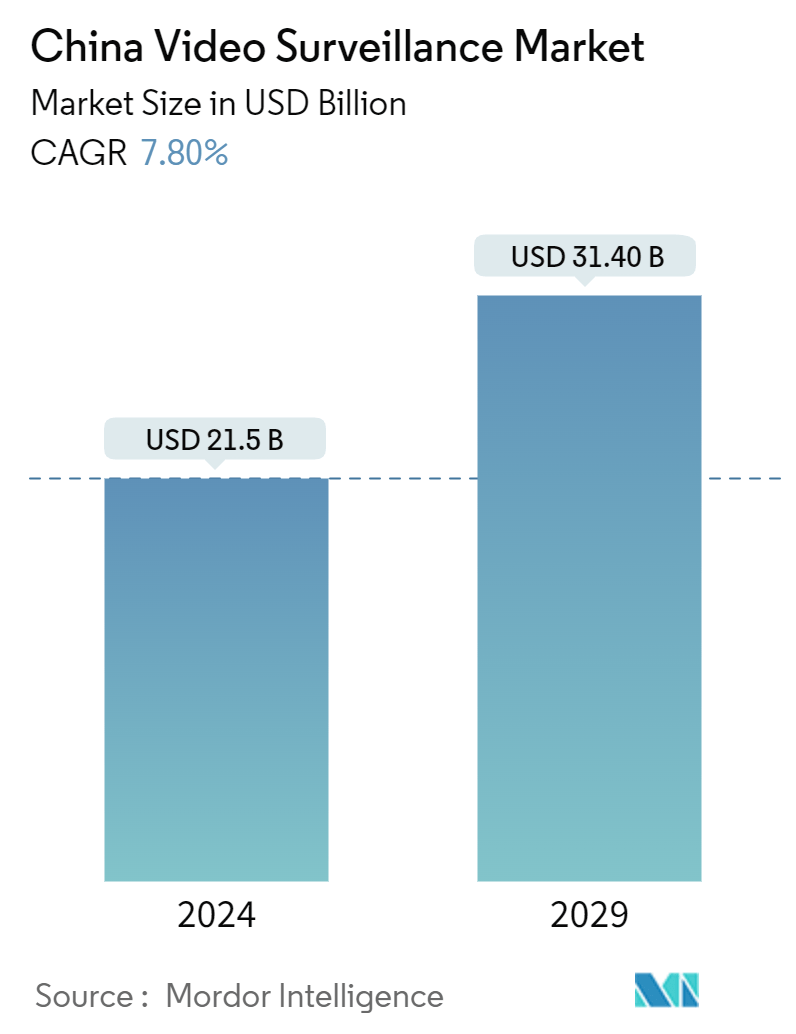Market Size of China Video Surveillance Industry

| Study Period | 2019 - 2029 |
| Base Year For Estimation | 2023 |
| Market Size (2024) | USD 21.5 Billion |
| Market Size (2029) | USD 31.40 Billion |
| CAGR (2024 - 2029) | 7.80 % |
| Market Concentration | High |
Major Players
*Disclaimer: Major Players sorted in no particular order |
China Video Surveillance Market Analysis
The China Video Surveillance Market size is estimated at USD 21.5 billion in 2024, and is expected to reach USD 31.40 billion by 2029, growing at a CAGR of 7.80% during the forecast period (2024-2029).
- China has undergone rapid urbanization and infrastructure development, leading to the construction of new cities and the expansion of existing ones. This has created a demand for advanced video surveillance systems to monitor public spaces, transportation networks, and critical infrastructure.
- The country has over 700 million surveillance cameras, one lens for every two citizens. These cameras identify an individual by their body movement through facial recognition or gait recognition technologies. In addition, according to the Australian Strategic Policy Institute and the non-governmental research partner, the Chinese public generally approves of the widespread use of surveillance technologies. On a scale of 10, most respondents rated their trust in central government positively at an average of 7.3. Regarding video, audio, or Internet surveillance, the business received a rating of 6.7. This type of approval for video surveillance by its people nationwide attracts market growth.
- Further, the Chinese government has actively promoted the development and implementation of video surveillance systems as part of its broader strategy to enhance public safety and maintain social stability. Government initiatives such as the Golden Shield project, Safe Cities, SkyNet, Smart Cities, and Sharp Eyes program have led to increased investment in video surveillance technology.
- Moreover, the advancements in video surveillance technologies have played a significant role in the market's growth. Chinese companies have been at the forefront of developing and deploying these technologies, making them more accessible and affordable. For instance, integrating video surveillance with artificial intelligence (AI) and big data analytics has expanded the capabilities of these systems. AI-powered video analytics can automatically detect and analyze suspicious activities, identify individuals, and generate real-time alerts, enhancing the effectiveness of video surveillance in various applications.
- Further, China has a robust domestic video surveillance industry, with several prominent companies leading the market. According to the report from RFE/RL, Dahua and Hikvision, two Chinese companies have become the world's leading providers of closed-circuit television and surveillance systems, dominating markets in Hungary, Serbia, Romania, Moldova, Ukraine, Bosnia-Herzegovina, Kosovo, Bulgaria, and Georgia. Their competitive pricing, technological expertise, and strong government support have contributed to the market's growth.
- However, the extensive collection and storage of personal data through video surveillance systems raise concerns about data privacy and security. In addition, the use of advanced technologies, such as facial recognition, raises ethical concerns regarding surveillance and potential misuse. According to IPVM, Dahua, a Chinese manufacturer of surveillance equipment, sells cameras with a "skin color analysis" function in Europe. Human rights and civil liberties concerns arise as regards the identification of skin color in surveillance applications. These types of incidences may hinder the market growth during the projected period.
China Video Surveillance Industry Segmentation
A video surveillance system comprises a network of cameras, monitors, display units, and recording devices. Analog or digital cameras can be used with various features such as resolution, frame rate, and color type. The purpose of the cameras is to deter illegal behavior, and video footage may also be used as evidence for future review by security personnel or law enforcement officers. Most video surveillance systems are designed to be secure so that signals can not be transmitted to unauthorized persons.
The Chinese video surveillance market is segmented by type (hardware [camera [analog, IP camera, and hybrid], storage), software [video analytics and video management software], and services [VSaaS]) and end-user verticals (commercial, infrastructure, institutional, industrial, defense, and residential). The report offers market size and forecasts for all the above segments in value (USD).
| By Type | ||||||||
| ||||||||
| ||||||||
| Services (VSaaS) |
| By End-User Verticals | |
| Commercial | |
| Infrastructure | |
| Institutional | |
| Industrial | |
| Defense | |
| Residential |
China Video Surveillance Market Size Summary
The China video surveillance market is experiencing significant growth, driven by rapid urbanization and infrastructure development. The demand for advanced surveillance systems is increasing as new cities are constructed and existing ones expand, necessitating the monitoring of public spaces, transportation networks, and critical infrastructure. The widespread acceptance of surveillance technologies among the Chinese public, coupled with government initiatives like the Golden Shield project and Smart Cities programs, has further fueled market expansion. Chinese companies, such as Dahua and Hikvision, are at the forefront of developing and deploying these technologies, integrating artificial intelligence and big data analytics to enhance surveillance capabilities. This robust domestic industry, supported by competitive pricing and technological expertise, is a key driver of market growth.
The market is also benefiting from the rise of IP cameras and cloud-based solutions, which offer flexibility, scalability, and cost-effectiveness. These technologies are increasingly integrated into IoT ecosystems, providing comprehensive security solutions. Additionally, China's emphasis on national security and substantial defense budget have led to significant investments in advanced surveillance technologies for border control and military applications. However, concerns regarding data privacy and ethical implications of surveillance technologies pose challenges to market growth. Despite these concerns, the market remains consolidated with major players like Hikvision and Dahua, who continue to innovate and expand their product offerings to maintain their dominant positions.
China Video Surveillance Market Size - Table of Contents
-
1. MARKET INSIGHTS
-
1.1 Market Overview
-
1.2 Industry Attractiveness - Porter's Five Forces Analysis
-
1.2.1 Threat of New Entrants
-
1.2.2 Bargaining Power of Buyers
-
1.2.3 Bargaining Power of Suppliers
-
1.2.4 Threat of Substitute Products
-
1.2.5 Intensity of Competitive Rivalry
-
-
1.3 Industry Value Chain Analysis
-
1.4 Technology Snapshot
-
1.5 Impact of Macro Trends on the Market
-
-
2. MARKET SEGMENTATION
-
2.1 By Type
-
2.1.1 Hardware
-
2.1.1.1 Camera
-
2.1.1.1.1 Analog
-
2.1.1.1.2 IP Camera
-
2.1.1.1.3 Hybrid
-
-
2.1.1.2 Storage
-
-
2.1.2 Software
-
2.1.2.1 Video Analytics
-
2.1.2.2 Video Management Software
-
-
2.1.3 Services (VSaaS)
-
-
2.2 By End-User Verticals
-
2.2.1 Commercial
-
2.2.2 Infrastructure
-
2.2.3 Institutional
-
2.2.4 Industrial
-
2.2.5 Defense
-
2.2.6 Residential
-
-
China Video Surveillance Market Size FAQs
How big is the China Video Surveillance Market?
The China Video Surveillance Market size is expected to reach USD 21.5 billion in 2024 and grow at a CAGR of 7.80% to reach USD 31.40 billion by 2029.
What is the current China Video Surveillance Market size?
In 2024, the China Video Surveillance Market size is expected to reach USD 21.5 billion.

